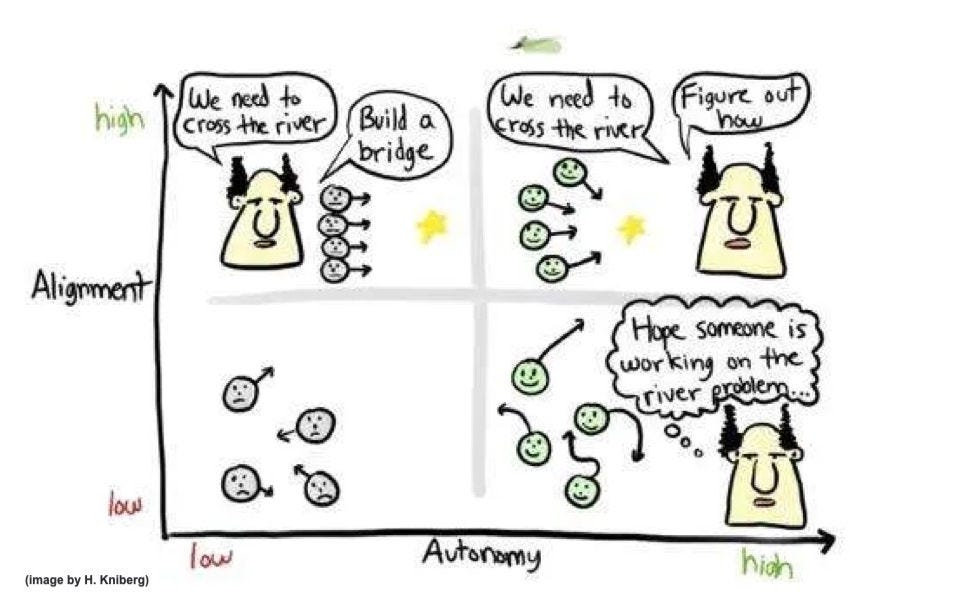From Aspiration to Execution
How to Make Autonomy Actually Work
The Tension
Every leader wants “aligned autonomy,” the dream upper right quadrant from Henrik Kniberg’s 2×2. I used this for many years to illustrate the idea of a more empowered, bottom’s up structure. And for many years, I misinterpreted this and caused unnecessary confusion.
Looking back, here’s what I know from my own mistakes and from what I see from working with startup teams:
In the spirit of honoring autonomy, leaders (CTOs, Founders, CPOs, etc) tell teams to “set your own goals and own your roadmap.” Then those same leaders complain nothing is shipping fast enough, or that the work doesn’t move the company forward.
Usually, this comes from a good place! We want empowered teams feeling accountable for outcomes, doing the best work of their lives. But…I’ve also seen this from a place of fear — shying away from clear direction out of fear the team will revolt or quit. 😩
The job of leadership is to frame the opportunity with precision. And — stay with me here — it’s okay to be heavy handed about it.
Crossing The River, Revised Edition
To illustrate the nirvana of perfect alignment and autonomy, the leader in the cartoon says: “We need to cross the river. Figure out how.” Sensible at first glance — set the goal and let team the figure out how. But, a more actionable frame might be:
“This is the river. This is the bank we’re aiming for. Here’s the weather you must respect. Based on what you know, where do you see this differently?”
Presuming the teams deeply understand their customer, their JTBD, their tech stacks, etc, expect them to bring real leverage to the problem space with an opinion on the order of operations.
If the team disagrees, they should prove it with the identical framing (bring the insights). If they’re right, you’ve found a sharper problem. If they’re wrong, you’ve strengthened alignment. Either way, the customer and business wins.
Example: Analytics for Enterprises
Frame: 25% of enterprise deals stalled because customers needed role-based access controls to switch. That’s $1.2M in pipeline this quarter.
Constraints: Must ship in <90 days; no re-architecture of identity services.
So what: How might we close this gap to unlock those deals and hit our Q2 revenue target?
Set direction, define boundaries, and tie to financial impact. This is strategy.
Too often leaders show up to planning empty-handed, waving around strategy slides, rah rah speeches from All Hands, or lofty OKRs. But those aren’t actionable inputs for teams.
Now, let’s evolve this into something meaty and concrete. Before you ask teams to write a roadmap, arm them with FOCUS.
The F.O.C.U.S. Brief (Quarterly, Team-Level)
F.O.C.U.S. is an exercise in rapid, disciplined writing by leadership. Wait, writing!? 🫢Yes, writing still matters — crisp writing is evidence of clear thinking, and spending millions each year even on a few small teams demands clear thinking. (Use your actual brain before turning to AI to help augment.)
It’s the bumper lanes for a team’s quarter:
Frame the problem: Why this, why now, and for whom.
Outcome: The single metric that matters this quarter, plus guardrails.
Constraints: Timebox, budget, quality bars, tech boundaries.
Universe of autonomy: The space the team controls, including leading metrics they’ll use to know if it’s working.
Stop rules: Kill criteria, pivot signals, review cadence.
➡️ In a past role, we had the cost of each team on a spreadsheet and stared at it every quarter. Every quarter, we asked: Would we write this $1M check against the direction we’re giving them? What precision do we owe them to get the most ROI back? That mindset forces clarity.
Imagine the CTO, CMO, CEO, CPO, Founder getting aligned behind a few of these — this is product work at the heart: Editing, crystalizing. If you can’t frame the bet crisply, you shouldn’t write the check.
Teams move fastest when the lanes are clear and the finish line is real. That’s not less autonomy — that’s what makes autonomy work.
Three Moves For This Quarter
What leaders want:
Autonomous progress on the right problems
To predictably buy outcomes with bounded risk
Teams that surprise them with how, not what, they’re chasing
So, try this next quarter:
Name the bottleneck. Growth, retention, sales friction, reliability, etc. Write one F.O.C.U.S. Brief per team. Open up debate and dialogue the week before planning.
Publish constraints and kill criteria. Remove ambiguity; speed comes from clarity.
Change the review. Don’t ask for status. Ask: What did you try? What did you learn? What decision did you make? How did the metric move?
The discipline of writing F.O.C.U.S. Briefs forces leaders to do their job: Define the river, name the bank, respect the weather, and tie it back to outcomes. Then hand the wheel to the team. (P.S. This is also powerful coaching for those teams to do the same thing: Frame and execute.)
That’s how autonomy — fueled by clarity — actually creates a culture of speed.
How about you? What’s worked, where do you see this differently?
Bottom line: Leaders owe their teams a crisp frame of the problem, boundaries, and outcomes so teams can own the “how” with speed and confidence. A F.O.C.U.S. Brief is one way to turn aspiration into action, and action into results.




Loved this article! So often in my career, I've felt like the leadership direction was too lofty or too heavy-handed - this framework strikes at that and finds the right balance.